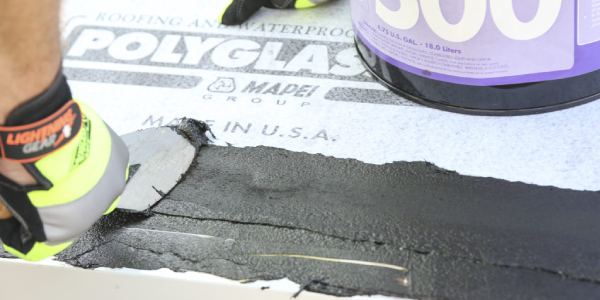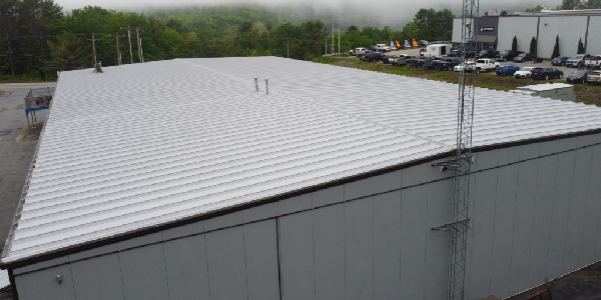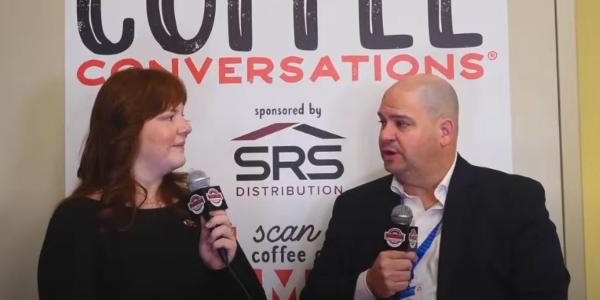Understanding the when, why and where of roof cement and roof mastics

By Polyglass.
There are multiple options for sealing your roof off and it can be hard to know the difference between each type. Use this guide to learn what system to use where.
Overall, there are four main ways to counteract leaks, light wear and sealing off flashing: roofing cement, roof mastics, flashing cement and cold adhesives. Across the industry, there is some confusion about the difference as there are a lot of slang and colloquial terms used on a job site. There is also some confusion in more formal settings, such as the ASTM material classes. ASTM chose to title their product class “roof cement,” not roof mastic as it is technically categorized (see ASTM D 4586 Standard Specification for Asphalt Roof Cement – Asbestos Free). Luckily, the experts here at Polyglass have your back and are here with a short guide to the different sealing options.
Should I use a roof cement or roof mastic?
When looking closely at these different types of materials, the reality is that in nearly every case, we find more similarities than differences – roof cement and roof mastics are the same. Often the term “mastic” is used in reference to its application as an adhesive to bond layers, which is thinner, usually applied by spray or squeegee, and not used as a topical application. Mastics (which are much thicker) are typically a topical application and applied by a trowel.
To add to this confusion, neither roof mastics nor cements are a best practice for bonding membrane layers. Using cold adhesives – modified or non-modified – is a best practice for bonding membrane layers. Polymer-modified cold adhesives are optimal when bonding compatible polymer-modified membranes.
In addition, flashing cements are a best practice for bonding membranes at details (horizontal to vertical) instead of the field of the roof (horizontal only). Like cold adhesives that are modified and non-modified for the roof field, flashing cements are also available in modified and non-modified versions for compatible membranes at detail locations. This applies whether the slope is considered low-slope or steep-slope.
Cold adhesives: A modern roofing solution
In decades past (over 20 years ago), when traditional built-up roofing (BUR) was king, there were fewer products to use than today. These heavy, trowel-grade materials were used as a topical material to seal details (as a secondary seal) but also the only option for bonding conventional membranes at details or for repair/maintenance of your BUR. There were few uses for cold bonding of traditional membrane materials, whereas it is now commonplace to use cold adhesives to bond polymer-modified membranes.
Whether you refer to the material as a roofing cement or roof mastic, its primary use is as a topical application over the membrane, be it a newly installed roofing membrane system or the repair/maintenance of an existing one. There are options in this material class; the more common selection includes asphalt-based cutbacks containing mineral spirits and sometimes certain reinforcing fillers. The other option is an asphalt-based cut-back that may consist of mineral spirits, where the asphalt base is modified with polymers to add flexibility and improve aging performance.
Polymer-modified cements and mastics offer better performance
If the choice is optimal performance, using polymer-modified materials is the easy and logical choice. Does this version of roofing cement (or roof mastic) cost more upfront? Sure. But as with many other situations, the minimal increase in material costs provides superior performance to non-modified versions.
When considering performance, one must also consider longevity. Is the choice to use a material that will age more quickly and require frequent maintenance or repair? If longevity is an important factor, then proper use and the use of a material’s best design practice are key. Choosing a superior product will take average performance and elevate it to a higher level of success.
When all things are considered, what needs to be decided is not whether to call it a “roof cement” or “roof mastic;” the choice is between performance. Polymer-modified materials are the best choice and a best practice. When considering use with polymer-modified membranes, a polymer-modified roof cement (or roof mastic) is the ONLY natural choice.
Polyglass offers various polymer-based and non-polymer-based asphaltic products for the field and details of the roof, whatever the roof design needs. Contact us today for more information.
Original article and photo source: Polyglass
Learn more about Polyglass in their Coffee Shop Directory or visit www.polyglass.us.






















Comments
Leave a Reply
Have an account? Login to leave a comment!
Sign In